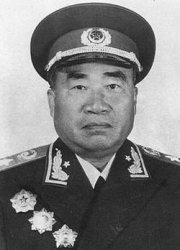![]() The Pacific War Online Encyclopedia
The Pacific War Online Encyclopedia
|
| Previous: Chu Shao-liang | Table of Contents | Next: Chuchou |

Chu Teh (Zhu De) was born in Yunnan province, China,
the fourth child in a family so impoverished that the seven children
born after him were drowned at birth because they could not be fed. He
was fortunate enough to receive a classical Chinese
education paid for by his clan.
This allowed him to pass the civil service examination. However, Chu
switched to a military career, graduating from the Yunnan Military
Academy in 1906. He invaded Szechuan in support of the Revolution of
1911, but when Yuan Shi-k'ai attempted to set himself up as emperor,
Chu set himself up as the warlord of Szechuan, becoming exceedingly
wealthy and temporarily addicted to opium.
Chu rediscovered his nationalist ideals in 1919, traveled to Germany to study at Goettingen University, and there was recruited into the Communist Party by Chou En-lai. After being expelled from Germany in 1926, ee returned to China, where he became Chief of Public Security in Nanchang and of the Kuomintang Officer's Training Corps, concealing his Communist party membership. He became a general in the Communist forces, and supported the Communist uprising at Nanchang on 1 August 1927. When the Autumn Harvest assault on Changsha in September collapsed, both Chu and Mao fled across the mountains to Kiangsi, where they established the Kiangsi Soviet area. Chu led the breakout and Long March of 1934, but was outmaneuvered politically by Mao, and ended up siding with the latter in his takeover of the Communist Party in January 1935. Chu's great popularity with the troops, which amounted nearly to a personality cult, made him very useful to Mao. Together they devised a 16-character formula for guerrilla strategy (Boot 2013):
When the enemy advances, we withdraw.
The enemy camps, we harrass.
The enemy tires, we attack.
The enemy retreats, we pursue.
Once the Communists were established at Yenan in Shensi province,
Chu established the Chinese
Communist 8
Route Army, which was the main Communist field formation and
forerunner of the People's Liberation Army. He was reputedly as
good or better than any Kuomintang
general.
Chu is credited with organizing the Hundred Regiments Offensive in
1940. This was a guerrilla
campaign against Japanese
communications in northern
China. However, Mao did not
trust Chu and kept him in Yanan, and the real mastermind behind the
Hundred Regiments Offensive was likely Chu's deputy, P'eng Te-huai.
The Japanese were greatly annoyed by the Hundred Regiments Offensive, and responded with the anti-Communist pacification campaigns know as the Sanko or "Three Alls" (kill all, loot all, burn all.) It is estimated that 90,000 Communist troops were lost in the campaign. Militarily, the campaign was a disaster, but the Communists turned it into a propaganda triumph, establishing a pattern for insurgencies throughout the remainder of the 20th century.
Thereafter, at Mao's insistence, 8 Route Army avoided field operations against the Japanese and concentrated on infiltrating into areas swept clear of Kuomintang forces by the Japanese advance. By the time the Pacific war ended, 8 Route Army had 800,000 trained soldiers, and it controlled much of the countryside. Nationalist generals who accepted the surrender of Japanese formations found that they controlled the major cities and railroads, and little else.
Chu directed the successful civil war and became Mao's first Defense Minister in 1949. He was effectively retired in 1955, suffered during the Cultural Revolution (when propaganda posters denounced him as a "Big Warlord" and "Black General"), but his life was saved through the influence of Chou En-lai and he was rehabilitated before his death.
| 1886-12-18
|
Born at Ni Lung in Szechuan
province |
|
| 1909 |
Yunnan Military Academy |
|
| 1916 |
Brigadier
general |
|
| 1922 |
Joins Kuomintang |
|
| 1922 |
Student in Germany |
|
| 1927 |
Joins Mao Tse-tung. Commander,
Nanchang Garrison |
|
| 1931 |
Commander, Chinese Communist Army |
|
| 1934 |
Commander, 1 Front Army, Long
March |
|
| 1937 |
Commander, 8 Route Army | |
| 1937 |
Commander, 18 Army Group |
|
| 1945 |
Commander, People's Liberation
Army |
|
| 1949 |
Minister of Defense |
|
| 1954 |
Deputy chairman, People's
Republic of China |
|
| 1959 |
Chairman, National People's
Congress |
|
| 1967 |
Blacklisted during Cultural
Revolution |
|
| 1971 |
Rehabilitated. Chairman,
Standing Committee of the National People's Congress |
|
| 1976-7-7 |
Dies |
References
ChinesePoster.net (accessed 2011-8-26)
Generals.dk (accessed 2008-2-4)
People.com.cn (accessed 2011-8-26)
The Pacific War Online Encyclopedia © 2007-2008, 2011, 2013 by Kent G. Budge. Index